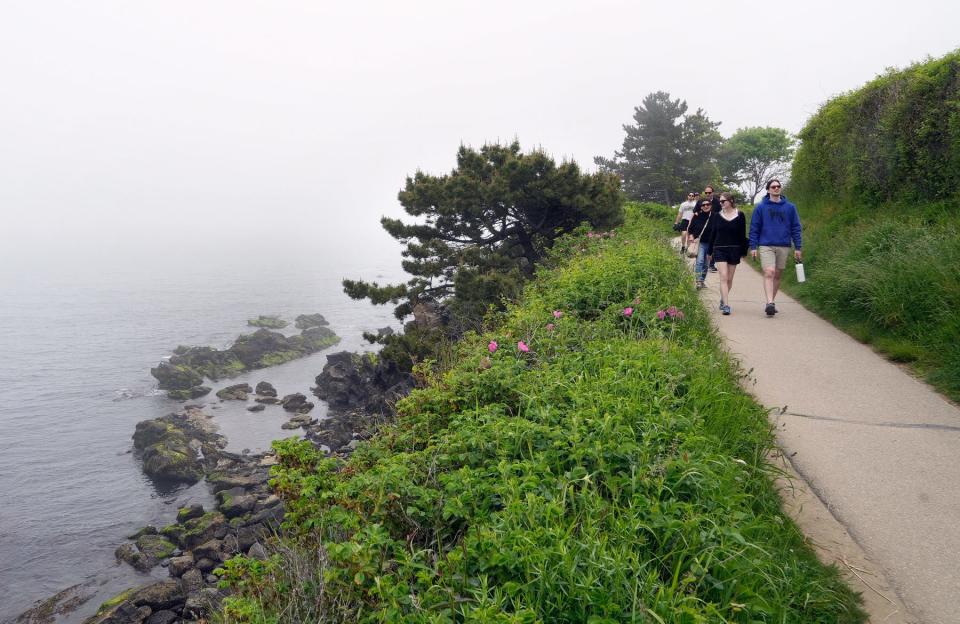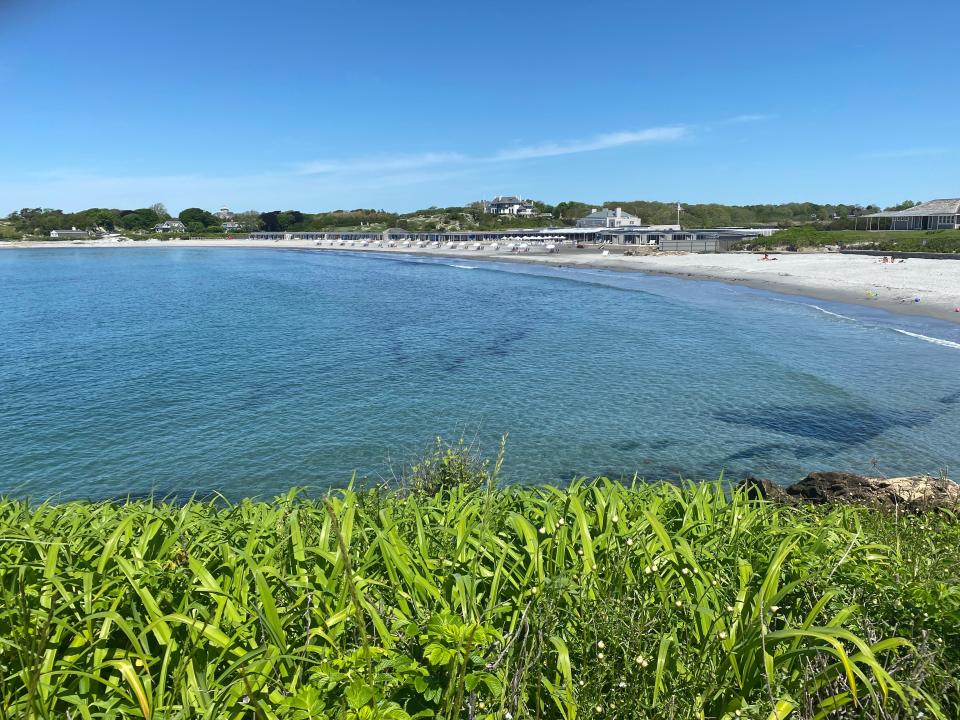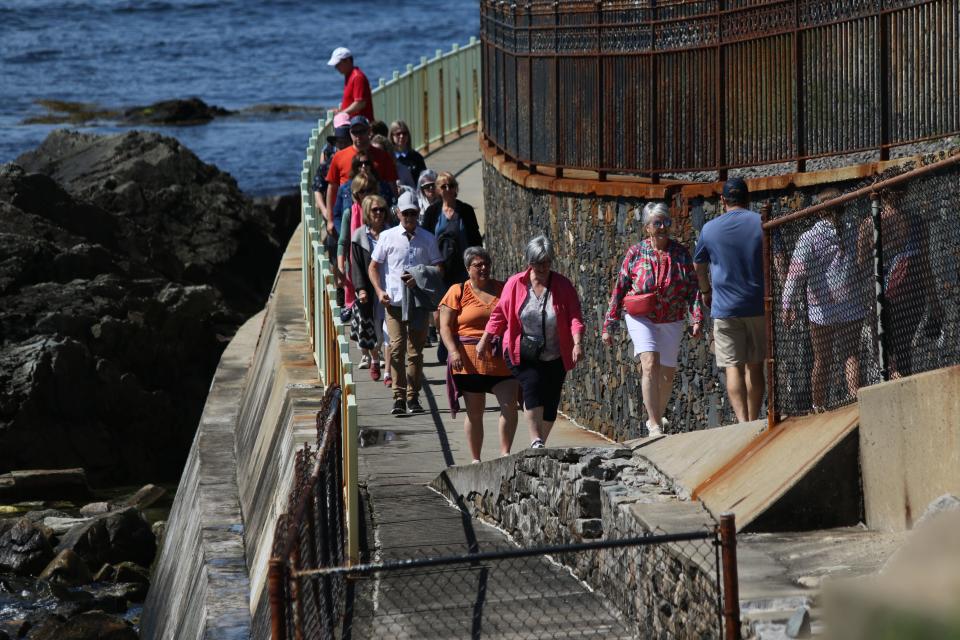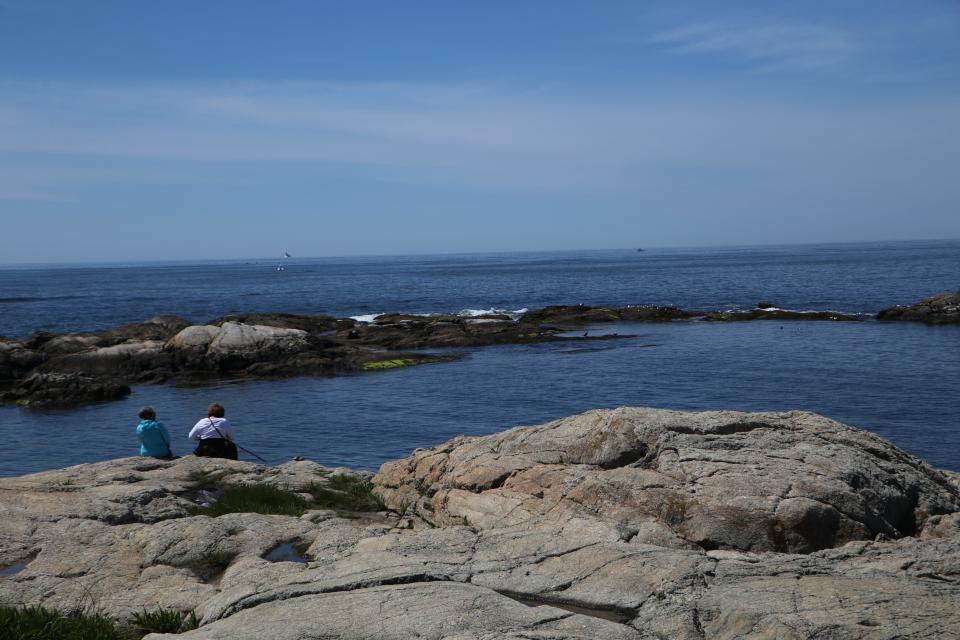The Cliff Walk continues to crumble into the sea. Are repairs worth Newport's investment?
As more frequent and intense storms have battered Newport's famous Cliff Walk, causing chunks to plunge into the waters below and sinkholes to appear without warning, millions of public dollars have gone into the trail, and almost as quickly, nature has wiped the repairs away.
It's an issue that's existed for nearly a century, but the accelerating storm threats of climate change are raising a new question: Is continued investment in the nationally recognized yet steadily crumbling trail the right decision for a city that’s already struggling with other, more pressing financial burdens?
The cost to battle storm after storm
“Whatever the Cliff Walk had been before, it would never be the same again.”
In 1988, Larry Lowenthal, a researcher for the National Park Service, wrote those words to describe the devastation inflicted on the iconic trail by the 1938 New England Hurricane, a brutal Category 3 storm that battered Rhode Island and the rest of the region. The “once-in-a-century” storm washed out large sections of the walking trail that had already established itself as a highlight of the city’s tourism economy, featured in guides and publications of the time advertising the city as a destination for people to come and gawk at the well-to-do in their manors lining the cliffs.

It is just after the Great Storm, Lowenthal wrote, that public funds of any kind were first used on an area near the Cliff Walk, if only because it abutted a public road. Still, even as the city’s Public Works Department began performing some repairs and maintenance to the trail after World War II, by the 1950s, the historic path was in a state of “steady deterioration.”
It wasn't until 1971 that the U.S. Army Corps of Engineers was able to start restoration on four of the trail’s sections. The Cliff Walk received an official National Historic Trail designation by the end of the 1970s, and more money began to pour into restoration of the walk, but, “as fast as money was filling in one section, other portions were washing out,” Lowenthal noted.
Much of the same can be said about spending on the Cliff Walk today, as its popularity as an icon of the city and tourist attraction remains unquestioned. A study conducted by Salve Regina University students in 2016 estimated the trail accounted for more than $90.45 million in indirect and induced annual spending in the city. A 2018 study increased that estimated impact to $115.39 million, with the trail attracting 1.3 million visitors annually.
How much do Cliff Walk repairs cost and how much has been spent?
These studies were used to justify some of the recent spending on repairs to the walk, but state and federal agencies have chipped in money to repair the trail for years.
In 2005, the Rhode Island Department of Transportation spent $4.3 million to reconstruct 2.3 miles of the Walk between Ruggles Avenue and Bailey’s Beach. Six years later, in 2011, RIDOT received $608,646 in federal funds from the Federal Highway Administration and made it available to the city on a reimbursement basis to repair the seawall near The Breakers estate; $309,200 of that would be awarded for the project in September 2012.

However, just one month later, Superstorm Sandy hit Rhode Island.
It was a significant blow to the trail. Sections once again washed away, a 15-foot-deep chasm opened up near Doris Duke’s Rough Point estate and a sinkhole emerged behind Miramar. The city would end up closing the Cliff Walk to the public for a year and a half while a new influx of public funds went toward preserving the historic trail.
Thankfully for Newport, RIDOT agreed to oversee the design and construction to repair the damage caused by Sandy in February 2013 through the federal Disaster Relief Appropriations Act. Although the department had initially planned to spend $6.8 million on post-Sandy repairs to 27 locations between Ruggles Avenue and Bailey’s Beach, it would end up spending $5.13 million, the revised plans a result of pushback from surfers who objected to the potential impact on the popular surfing spot.
In the meantime, the city was working on its own repair plans. The Breakers seawall project contract awarded in 2012 received a $12,000 increase because of the erosion from Sandy, and the city awarded another contract for $33,440 for oversight and documentation.

The Rhode Island Historical Preservation and Heritage Commission also contributed cash to the repair efforts, awarding the city a $254,118 grant in April 2014 to repair three damaged areas along the walk. In August 2015, the city petitioned for additional funding from the preservation commission, scoring another $346,820. The grant would end up funding the $91,256.23 contract for engineering services and the rest would go toward the $1.036 million contract for the actual construction.
The city used $455,310 of its own capital improvement funds to pay for the remainder of the construction contract, which was awarded in 2016. The following year, the city made another nearly $1 million repair to the Cliff Walk, $600,938 of which was funded through the National Park Service’s Hurricane Sandy relief funds, $200,000 was provided by RIDOT and the city made up the remainder.
Yet, in just five years, the Cliff Walk faced another major failure. However, unlike in 2012, the March 2022 collapse between Narragansett Avenue and Webster Street was not caused by a hurricane, but rather from unseen damage unidentified through previous repair efforts. Another section in the same area collapsed in December of that year following a particularly intense series of winter storms.
This time, the city put more of its own skin in the game, transferring $218,815 from its funds set aside for property acquisitions to fund a contract with GZA Geoenvironmental to investigate the collapse and develop preliminary designs for repairs. The firm would receive another contract from the city in January 2024, this time for $414,580 that was already budgeted, for design and construction administration of the repairs.

That money, however, is just for GZA Geoenvironmental’s services. Just recently, the city finally secured $16 million in federal funds to actually repair the collapse, with an additional $5 million in matching funds from the city to be allocated to the trail should Newport voters decide to support a $98.5 million infrastructure bond this November. Another $8 million is being sought through a bond proposed by Gov. Dan McKee.
In just shy of two decades, this 3.5-mile trail has absorbed more than $28.7 million, at least $22.3 million of which has been federally sourced. Despite these investments, its position on the edge of the island means the trail is perpetually facing the possibility of additional failures as soon as the next major storm hits.
The challenges of maintaining the Cliff Walk
It was around the time Scott Wheeler took on his role as Newport’s superintendent of parks, grounds and forestry in 1996 that the city began taking a more active role in maintaining the vegetation, the viewshed and the walking paths along the Cliff Walk, he said. Nowadays, the city performs regular maintenance on a weekly basis, clearing vegetation, checking signage, cleaning garbage and responding to any complaints.

“It is a challenging property to maintain, but it really is the jewel of not only Aquidneck Island, but it's the jewel of Rhode Island,” Wheeler said.
The city has different approaches to managing and maintaining different portions of the Cliff Walk. The portion from Easton’s Beach to the Forty Steps, which was mostly constructed by the Army Corps of Engineers in the 1970s, is pretty stable and requires little attention from the city. Similarly, the section just after Miramar going down to Bailey’s Beach, composed largely of natural bluff and boulders, is considered a natural trail with little built onto it that could fail.
It’s the areas that were reconstructed following the Hurricane of 1938, Wheeler said, that the city has to watch. The sea walls around Shepard Avenue and behind The Breakers, for example, occasionally need to be repaired, especially at the tide line, as the regular pounding of the waves erodes the stone and mortar.

“There’s large sections, probably the majority of the Cliff Walk, that’s really not at risk at all. It’s just these segments that need to be monitored a little closely, and periodically they need to be improved,” Wheeler said. “Hopefully, as we restore these areas, we’re moving toward systems that are more resilient.”
He noted, however, that there is a balance to be struck when considering these more resilient repairs. While large armor stones may stabilize the Cliff Walk better than other alternatives, they affect the natural characteristics of the surrounding area, as the city learned when surfers objected to the state’s 2013 post-Sandy repair proposal.
Is there a better way?
With so much of the money supporting Cliff Walk repairs coming from the federal government, it may be a surprise to learn that the idea to add the National Historical Trail as a part of the National Park System has been rejected not once, but twice.
Lowenthal’s 1988 article was commissioned as a part of an application to admit the Cliff Walk to the system, an effort led by U.S. Sen. Claiborne Pell. In that article, Lowenthal mentions the previous failed effort to do the same in 1959, when the assistant secretary of the Interior concluded that the department “does not believe the Cliff Walk has the essential natural and historic qualities that justify its inclusion in the National Park System.”
The later effort likewise failed, but for different reasons. While the 1987 bill (S323) Pell introduced died in committee, the special study that was commissioned to support the bill revealed one of the main issues holding back the possibility of any larger government control of the trail: the property rights of the people who own the land on which the Cliff Walk sits.

Unlike most trails or parks, the Cliff Walk is not one contiguous, singularly owned stretch of land. Instead, as a result of its own unique history, it is a series of easements granted by the property owners that abut the trail, a position many of those along the Cliff Walk take with great pride, according to Salve Regina University professor Samuel Sacco.
“I can’t see Salve ever relinquishing control over it, and I can’t see any other private property owners doing it either,” Sacco said. “You own right up to the high tide line, and that’s just such a unique experience and valuable position to be in. It just becomes part of the brand, part of the image. We have a responsibility to it. I think they would want to maintain it, to enjoy it, to educate, and I think they have handled that stewardship well, most of the property owners, and Salve certainly. I think they take that responsibility seriously, and I’m not sure how much value would be gained in going in another direction.”
Salve Regina University is one of the largest property owners along the Cliff Walk. Although Sacco’s opinion does not represent the university's official position on whether it would relinquish its rights over the Cliff Walk, he has become something of a resident expert on the trail at Salve, having overseen the aforementioned student-led studies as well as helping to create a Cliff Walk Ambassador program for students to promote knowledge and preservation of the trail. He sits on the city’s Cliff Walk Commission, representing the university’s interests as a property owner.

The Preservation Society of Newport County is another of the Cliff Walk’s largest abutters.
“We fully support the efforts being made to preserve the Cliff Walk and appreciate the hard work and dedicated focus of everyone involved in securing the funds necessary to rebuild and fortify this important Rhode Island landmark,” the Preservation Society's executive director, Trudy Coxe, said in a statement.
The Cliff Walk’s segmented ownership has helped and hindered preservation efforts in different ways. Some property owners have dipped into their own pockets to fund repair and maintenance work on the trail, such as in 2014, when a resident along the trail repaired a large section just north of Rough Point. Still, while the university and the Preservation Society, by their own admission, have not funded repairs to the Cliff Walk themselves, they generally work with the city to allow their maintenance crews onto their property.
More: What forced rich New Yorkers to let everyday people walk on the cliffs in Newport?
“The Cliff Walk, by its nature, is not great navigable waters. We can’t pull a barge right up to the shoreline, so one of the biggest expenses is, how do you bring all this equipment across these properties and these estates?” Wheeler said.
Others, however, have not been so cooperative.
In 2005, RIDOT’s $4.3 million reconstruction project hit a stumbling block when residents along Bellevue South objected to the state’s construction teams accessing their private road and making changes to their property, which abuts the Cliff Walk. The issue would ultimately be resolved a month later, in November, with the state having to build a temporary roadway south from Rough Point to access the project location.

Wheeler noted that the connection between properties and the Cliff Walk can also be a major factor in how property owners respond to construction on their properties. While the area around the Forty Steps has a good degree of separation between private homes and the public walkway, other properties further down do not have the same separation. In general, he said the city has been able to reach out to property owners and work alongside them to fix issues that arise.
The liability of the Cliff Walk
If making the trail into a national, or even state park, is not feasible because of the rights of the property owners, why not leave it up to those who own the trail to maintain and repair it? This question opens up another concern for the city regarding investments to the Cliff Walk, as it faces potential legal liability for those injured on the trail.
“There is a recognized public right of way along what is referred to as the Cliff Walk with the actual parameters not necessarily fully defined,” Newport City Solicitor Chris Behan said in a statement. “While for the most part, landowners will enjoy protections afforded by the Recreational Use Statute in terms of liability for losses occurring along the route, the RI Supreme Court has imposed a more expansive liability on the City based on a negligence standard. As a result, the City, in order to obtain funding for maintenance and repairs – and based on liability concerns – has undertaken the responsibility for the same.”

How did this come to be? The Supreme Court case Behan referred to had its start in 2000, when New York resident Simcha Berman, while on a honeymoon stroll along the Cliff Walk, plummeted 29 feet down to the rocks below the trail after the ground on what he thought was a path down to the water gave way beneath his feet, rendering him quadriplegic. Berman and his then-wife filed suit with the Superior Court in 2003 against the State of Rhode Island; the Preservation Society, on whose section of the trail the injuries occurred; and the City of Newport for negligence, alleging the parties had failed to properly inspect, maintain and repair the trail and warn visitors of its defects.
In 2005, the city and its fellow defendants moved for summary judgment on the grounds that the Rhode Island Recreational Use Statute, which protects public entities from personal injuries incurred from recreational use of public lands, immunized them from liability. However, the Superior Court denied summary judgment because of the ambiguity surrounding how the statute could be applied to the Cliff Walk’s unique situation. This changed in 2007, when the Superior Court granted summary judgment for the Preservation Society, which was affirmed by a 2010 Supreme Court decision.
The city, however, did not get off so easily. In 2010 the Supreme Court determined that the city knew about the conditions that made the Cliff Walk dangerous and had a duty to warn or guard visitors against those hazards.
“Quite appropriately, Newport jealously guards and promotes the Cliff Walk as a cornerstone of its tourism industry – an attraction that annually lures legions of visitors to the Atlantic coast,” Justice Maureen McKenna Goldberg wrote in the 2010 decision. “Newport has received more than $3.5 million in federal, state, and municipal funding for the Cliff Walk, and, to qualify for this money, the city declared its sovereignty over it. The city assumed control of the Cliff Walk, fully aware of the threatened stability of the walkway. However, at the same time, the city boldly argues that it has no duty to maintain the Cliff Walk or warn visitors about its latent dangers, and the city contends that it is immune from suit unless a city employee, by happenstance, is present on the Cliff Walk and fails to warn a visitor whom he sees approaching the unstable cliff edge. We reject these contentions.”
When the city returned to the Superior Court as a defendant in this case once more, it settled the case for the maximum allowable $2 million on the first day of jury trial, leaving the state to defend its case alone. Ultimately, the Superior Court found the state was not legally liable for Berman’s injuries, a decision the Supreme Court upheld in 2014.
Are the Cliff Walk investments worth it in the end?
Newport today is facing several financial demands without much means to meet them. While drafting the city’s fiscal 2025 Capital Improvement Plan, the city administration revealed that Newport has about $500 million in needed infrastructure repairs to tackle over the next five years. Meanwhile, the school department continues to grapple with the ballooning construction cost for a new high school that sits on contaminated soil. Residents themselves face significant increases in housing costs while battling the impacts of climate change within the walls of their own homes as stormwater floods their basements.
Through its approval of the FY25 budget on May 22, the Newport City Council approved a significant reorganization of the way the city operates, creating three main administrative “super” departments to which the other departments report back. One of the main reasons for this reorganization, interim City Manager Laura Sitrin explains in the budget documents, is to put climate change resiliency at the top of the city’s priorities through the creation of a Resiliency and Sustainability Department, which will oversee the Public Services, Utilities, and Planning and Zoning Departments.

For his department, which is now under the Resiliency and Sustainability umbrella, Wheeler said the biggest challenge is securing sustainable funding to continue the upkeep of those sections of the Cliff Walk that require the most attention, although they have been able to get revenue from parking meters over the years to fund other regular expenses, such as maintenance for the restrooms. The city is also currently seeking additional funding to conduct a full study of the Cliff Walk and create a management plan for the trail featuring the best practices the city has developed over the years.
Mayor Xay Khamsyvoravong said that, although he envisions more efficient ways to fund and maintain the historic trail, including handing it over to the National Park Service, being just 18 months into his first experience as an elected official, he is doing the best he can with the structure he has been given.
In that vein, however, Khamsyvoravong suggested that the Cliff Walk’s increasing vulnerability to the impacts of climate change may be exactly the reason the city needs to continue supporting it.
“The value that is received from the Cliff Walk is more than just the tourism dollars that have traditionally been generated as a by-product of people coming to enjoy it,” Khamsyvoravong said. “It's more than just the by-product of people using it as a way to get outside, and get exercise and fresh air and see these historical sites. This is also probably the most high-profile point in the state where you can visibly see the impacts of climate change.”
Beloved as it is, Khamsyvoravong said the Cliff Walk’s national acclaim can help showcase to those on the outside the challenges that the City by the Sea is facing.

“Think about the value of having the attention of over a million people per year looking at the impacts of these increasingly severe storms, of these increasingly severe rain events,” Khamsyvoravong said. “To stand there in person, to physically see it and feel it, is something that translates to something people will remember forever, and that is a very valuable opportunity for us to elevate the conversation we’re having. That is why we’re taking the investment in this Walk so seriously.”
Today, the Cliff Walk remains a mirror of its recent past. It is one of Newport’s most iconic and yet most challenging-to-maintain attractions, constantly battling the forces of nature on the front lines of climate change. Still, millions of dollars continue to be poured into keeping the trail alive, and not just because it serves as an emblem of Newport.
“The Cliff Walk has, indeed, changed drastically within the memory of today’s Newport residents, but there has never really been a time in history when it was fixed and stable,” Lowenthal concluded in his 1988 article. “If it is precarious today, perhaps that is its normal condition. As such, it illustrates the beauty, fragility and the impermanence of man’s relationship with nature.”
This article originally appeared on Newport Daily News: In battle against climate change, is Newport's Cliff Walk doomed?
